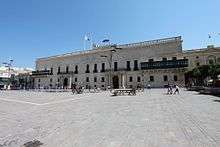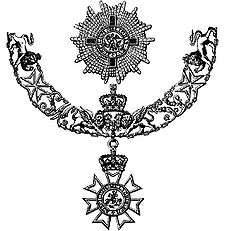Thomas Maitland (British Army officer)
Lieutenant General Sir Thomas Maitland GCB GCH (10 March 1760 – 17 January 1824) was a British soldier and colonial governor. He also served as a Member of Parliament for Haddington from 1790–96, 1802–06 and 1812–13. He was made a Privy Councillor on 23 November 1803. He was the second surviving son of James Maitland, 7th Earl of Lauderdale and the younger brother of James Maitland, 8th Earl of Lauderdale. Maitland never married.
Military service
Maitland was commissioned into the Edinburgh Light Horse, shortly after his birth, but did not take up his commission until he joined the 78th Foot as a Captain in 1778. He transferred to the 72nd Foot, and then to the 62nd Foot as a Major in 1790. He was promoted Lieutenant-Colonel in 1794 and Colonel and Brigadier-General in 1798.
While serving at St. Domingue, he proactively dealt with Toussaint Louverture, who was then a general in the French colonial force, to disengage Britain. Elkins and McKitrick[1] write:
It was in fact Maitland and not the War Ministry who had determined that Britain's only sensible choice, rather than try to maintain any kind of presence at Jérémie and Môle-Saint-Nicolas, was to deal directly with Toussaint and negotiate a total evacuation of the island. Accordingly he and the black general concluded a secret agreement on August 31, 1798. Great Britain would desist from any further attack on St. Domingue and any interference with its internal affairs; Toussaint made a similar promise with regard to Jamaica; and Maitland would see that provisions were allowed to reach the ports of St. Domingue without interference from British cruisers.
Governor of Ceylon
Maitland served as Governor of Ceylon (Sri Lanka) during 1805 to 1811.
In early 1812, Arthur Wellesley, Earl of Wellington began the campaign that resulted in his victory at the Battle of Salamanca on 22 July. To prevent Marshal Louis Gabriel Suchet from sending French reinforcements from the east coast of Spain, Wellington requested that Lord William Bentinck launch a diversionary operation using the British garrison of Sicily. At first Bentinck agreed to send 10,000 of his soldiers, but in March he reversed himself. After much persuasion, he allowed the operation to go forward and on 7 June he put 8,000 men aboard naval transports under the command of Maitland. The fickle Bentinck changed his mind again on 9 June, stopping the expedition. At last on 28 June Maitland sailed for Minorca. The fleet first picked up 6,000 Spanish troops at Minorca and landed on 31 July at Palamós, 65 miles (105 km) northeast of Barcelona. He wisely decided that Barcelona was too strong to attack, but he also refused to try to capture weakly held Tarragona.[2] Maitland soon received news that Joseph O'Donnell's Army of Murcia had been routed at the Battle of Castalla on 21 July. Without the support of O'Donnell, Maitland decided he could not accomplish anything. He re-embarked his expeditionary force and sailed to Alicante instead, joining his troops with the garrison to form an army of 15,000 men.[3] Because of the disaster at Salamanca, the French were forced to evacuate both Madrid in central Spain and Andalusia in the south. Their combined forces joined Suchet in the province of Valencia.[4] In close proximity to 80,000 French soldiers, Maitland declined to move from Alicante.[3] Maitland asked to be relieved in September 1812 due to illness.[5]
Love story at Ceylon

While at Ceylon, Maitland was attracted to a place at "Galkissa" (Mount Lavinia) and decided to construct his palace there.
During this time, Maitland fell in love with a half-caste dancing-girl named Lovina, who had been born to Portuguese and Sinhalese parents. During the construction of the palace, Maitland gave instructions for the construction of a secret tunnel to Lovina's house, which was located close to the governor's palace. One end of the tunnel was inside the well of Lovina's house and the other end was in a wine cellar inside the governor's palace. When the governor came to reside there, he would often use the tunnel to meet Lovina.[6][7]
The Sinhalese village that surrounded the Governor’s mansion developed into a modern city named "Galkissa". Later the city was renamed "Mount Lavinia" in honour of Lovina. In 1920 the tunnel was sealed up.
The bicentenary celebration of the Mount Lavinia Hotel was held in 2005. Some of Sir Thomas Maitland's relatives living in the UK attended the ceremony.[8]
Governor of Malta

Maitland became Lieutenant-Governor of Portsmouth and General Officer Commanding South-West District in May 1813[9] and was then appointed as Governor of Malta on 23 July 1813, when the island became a crown colony instead of a protectorate. The plague had broken out in Malta in March 1813 and the disease began to spread especially in Valletta and the Grand Harbour area. When Maitland arrived, he enforced stricter quarantine measures. The plague spread to Gozo by the following January, but the islands were free of the disease by March 1814. Overall, 4486 people were killed which amounted to 4% of the total population. It is thought that the outbreak would have been worse without Maitland's strict actions.
After the eradication of the plague, Maitland made several reforms. He removed British troops from Lampedusa on 25 September 1814, ending the dispute that had started in 1800.[10] On Malta, he was autocratic and he refused to form an advisory council made up of Maltese representatives, and so he was informally known as "King Tom". He formed the Malta Police Force in 1814, while the local Italian-speaking Università was dissolved in 1819. Various reforms were undertaken in taxation and the law courts as well. Maitland remained Governor until his death from apoplexy on 17 January 1824.[11] He was attended on his death-bed by doctors Robert Grieves, Alexander Broadfoot and John Hennen.[12]
While he was Governor of Malta, Maitland also served as Lord High Commissioner of the Ionian Islands during 1815 to 1823, while the islands were a British protectorate. The seat of administration was at Corfu.
See also
References
- ↑ The Age of Federalism, by Stanley Elkins and Eric McKitrick; Oxford University Press, 1995, ISBN 0-19-509381-X
- ↑ Glover, Michael (2001). The Peninsular War 1807–1814. London: Penguin. pp. 268–269. ISBN 0-141-39041-7.
- 1 2 Gates, David (2002). The Spanish Ulcer: A History of the Peninsular War. London: Pimlico. p. 364. ISBN 0-7126-9730-6.
- ↑ Glover (2001), pp. 207–210
- ↑ Glover (2001), p. 270
- ↑ Seneviratne, Maureen (1995) The story of Mount Lavinia Hotel McCallum Publishers, Colombo, Sri Lanka, pp. 20–22, OCLC 37579642
- ↑ Aves, Edward (2003) "Mount Lavinia" Sri Lanka Footprint, Bath, England, page 79, ISBN 1-903471-78-8
- ↑ "History of the Mount Lavinia hotel". Hotel's Website. Retrieved 2007-09-29.
- ↑ The London Gazette: no. 16733. p. 1018. 25 May 1813.
- ↑ Zerafa, Thomas (17 July 2011). "When the British planned to make Lampedusa part of the Maltese Islands". Times of Malta. Retrieved 21 September 2014.
- ↑ Sciberras, Sandro. "Maltese History – G. The First Years of British Rule 1800 – 1824" (PDF). St Benedict College. Retrieved 21 September 2014.
- ↑ http://maltaramc.com/regsurg/h/hennenj.html
Further reading
- Dixon, Cyril Willis (1939) The Colonial Administrations of Sir Thomas Maitland Longmans, Green and Company, London, OCLC 2888724; reprinted in 1968 by Cass, London, OCLC 461019
- Hulugalle, H. A. J. (1963) "Sir Thomas Maitland (1805–1811)" British Governors of Ceylon Associated Newspapers of Ceylon, Colombo, Sri Lanka, pages 18–25, OCLC 4175720
External links
- worldstatesmen.org
- regiments.org
- The Louverture Project: Thomas Maitland – Thomas Maitland and the Haitian Revolution.
| Political offices | ||
|---|---|---|
| Preceded by Frederick North |
Governor of Ceylon 1805–1811 |
Succeeded by John Wilson, acting |
| Preceded by Sir Hildebrand Oakes (Civil Commissioner) |
Governor of Malta 1813–1824 |
Succeeded by The Marquess of Hastings |
| New title | Lord High Commissioner of the Ionian Islands 1815–1823 |
Succeeded by Sir Frederick Adam |
| Parliament of Great Britain | ||
| Preceded by William Fullarton |
Member of Parliament for the Haddington Burghs 1790–1796 |
Succeeded by Robert Baird |
| Parliament of the United Kingdom | ||
| Preceded by Robert Baird |
Member of Parliament for the Haddington Burghs 1802–1805 |
Succeeded by John Dalrymple |
| Preceded by Sir George Warrender, Bt |
Member of Parliament for the Haddington Burghs 1812–1813 |
Succeeded by Anthony Maitland |
| Military offices | ||
| Preceded by Arthur Whetham |
GOC South-West District May 1813 – July 1813 |
Succeeded by William Houston |
| New regiment | Colonel of the 10th West India Regiment 1798–1802 |
Regiment disbanded |
| Colonel of the 5th Garrison Battalion 1803–1805 | ||
| Colonel of the 3rd Garrison Battalion 1805–1807 |
Succeeded by The Lord Forbes | |
| Preceded by David Douglas Wemyss |
General Officer Commanding, Ceylon 1805–? |
Succeeded by John Wilson |
| Preceded by Oliver Nicolls |
Colonel of the 4th West India Regiment 1807–1811 |
Succeeded by Sir James Leith |
| Preceded by Henry Edward Fox |
Colonel of the 10th Regiment of Foot 1811–1824 |
Succeeded by Sir John Lambert |
| Honorary titles | ||
| New title | Grand Master of the Order of St Michael and St George 1818–1824 |
Succeeded by The Duke of Cambridge |

